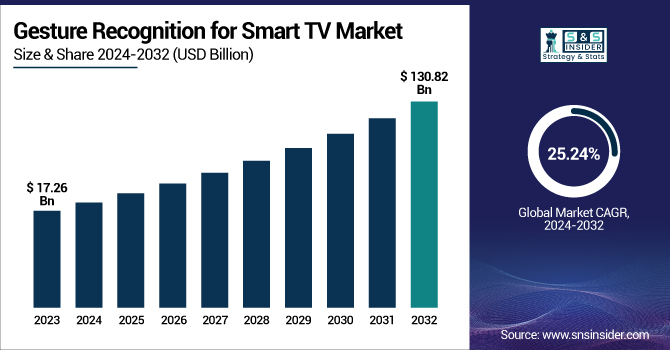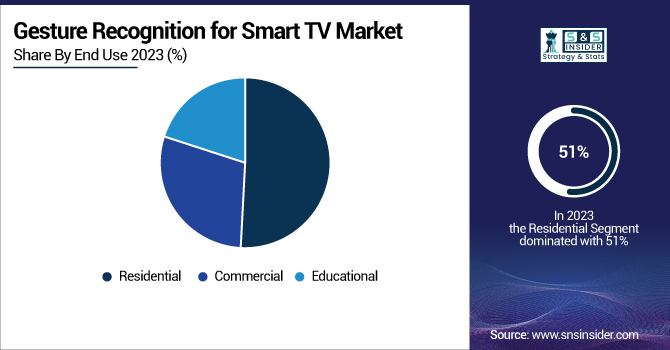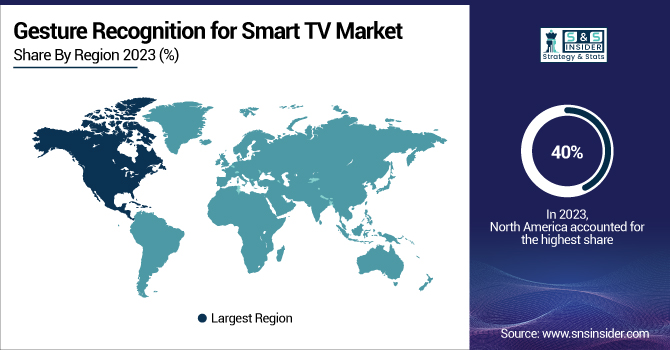Gesture Recognition for Smart TV Market Size Analysis:
The Gesture Recognition for Smart TV Market was valued at USD 17.26 billion in 2023 and is projected to reach USD 130.82 billion by 2032, growing at a CAGR of 25.24 % from 2024 to 2032.

To Get more information on Gesture Recognition for Smart TV Market - Request Free Sample Report
Technological innovations in AI, ML, and sensors, Combined with, Post-pandemic response from consumers seeking greater touchless control and smart-home integration are Among key drivers. With this fast-paced market, it is clear consumers are ready for intuitive, hands-free control for a fully integrated entertainment experience.
In the US market, it was valued at USD 4.73 billion in 2023 and is projected to reach USD 29.64 billion by 2032, with a CAGR of 22.61%. Smart home standards also serve to ensure safety, data privacy, and quality for devices, contributing to market growth through regulatory impacts. User experience metrics indicate that touchless gesture interaction increases user satisfaction, and is faster and more accurate, thereby promoting greater user adoption and engagement.
Gesture Recognition for Smart TV Market Dynamics:
Drivers:
-
Rising consumer demand for touchless control in smart TVs is driving the adoption of gesture recognition technology, enabling intuitive, hands-free interactions and enhancing convenience.
The rising consumer demand for touchless control in smart TVs is significantly reshaping the entertainment experience. As the number of users looking to control their devices in an easier way to continue to rise, gesture recognition technology has shown its important role in increasing user-friendliness, especially in a hands-free manner. Touchless control systems that let people use their smart TV models and use touchless interaction rather than remote controls are undoubtedly one of the tastefully modern/legacy technologies we see with smart TV, without compromising the lifestyle of the viewers. This trend is driven by the increasing prevalence of smart home technologies, where gesture recognition becomes an essential human interface to control multiple IoT devices. Moreover, as customers end up increasingly accustomed to virtual, tech-driven experiences, the choices for gesture-based primarily based enter keep rising. This trend is pushing manufacturers to innovate, integrating gesture recognition into their products, and accelerating market adoption, making it a critical factor in the expansion of the gesture recognition for smart TV market.
Restraints:
-
Limited accuracy and precision in gesture recognition systems, especially in low-light or complex gestures, can cause user frustration and slow smart TV adoption.
Limited accuracy and precision in current gesture recognition systems present a major challenge in the smart TV market. These systems often struggle to accurately detect gestures, especially in low-light environments or when users perform complex or subtle movements. As a result, users may experience frequent misinterpretations or delays, leading to frustration and diminishing the overall user experience. This issue becomes particularly noticeable in smart TVs where smooth, responsive interaction is key for enhancing the viewing experience. Moreover, environmental factors like ambient light or the distance between the user and the TV can significantly affect the system's performance. These limitations not only hinder consumer satisfaction but also slow down the widespread adoption of gesture recognition technology in smart TVs. Consequently, manufacturers must overcome these challenges to improve the reliability and usability of gesture recognition systems to meet consumer expectations.
Opportunities:
-
Leveraging Sensor Technology Advancements for Enhanced Gesture Recognition in Smart TVs
Advancements in sensor technology play a crucial role in enhancing the functionality of gesture recognition systems for smart TVs. Innovations in motion tracking, including higher sensitivity and improved precision, enable the system to detect even the most subtle or complex gestures with greater accuracy. Additionally, improvements in low-light performance are addressing one of the key limitations of current gesture recognition technology, ensuring that systems can function effectively in various lighting conditions. These developments not only enhance user experience by providing seamless interaction but also open up new opportunities for manufacturers to deliver high-quality, reliable gesture recognition systems. As sensor technology continues to evolve, gesture recognition in smart TVs will become more responsive and versatile, leading to broader adoption and a richer, more intuitive user interface. Consequently, advancements in sensors offer a significant opportunity to improve market competitiveness and drive innovation in the sector.
Challenges:
-
The Impact of High Development Costs on Gesture Recognition for Smart TVs
The high development costs associated with gesture recognition for smart TVs stem from the advanced technology required, including specialized sensors, AI algorithms, and complex software integration. Such systems depend on exact movement tracking, camera systems, and machine learning abilities, which will all need sufficient funding and time to be invested in research, development, and manufacturing. Consequently, the initial investment for smart TV manufacturers becomes pricier, which may directly affect the affordability of these innovative systems for users. These technologies must also be maintained and updated in order to stay competitive, which can also take more financial burden. Therefore, such high costs may restrict the mass-market adoption of the gesture recognition technology, especially in cost-sensitive markets, and hinder technology penetration in the mainstream consumer segment.
Gesture Recognition for Smart TV Market Segment Analysis:
By Product Type
The LCD Smart TV segment dominated the Gesture Recognition for Smart TVs market in 2023, accounting for approximately 38% of the total revenue. This dominance can be attributed to the wide scale adoption of LCD technology along with its low costs and known market presence. This makes LCD TV a good compromise for the consumer and still have a good visual output quality, which makes them an attractive choice as LCD display hardware to integrate gesture recognition system. Growth in smart TV demand and advancements in LCD panel technology have allowed manufacturers to integrate gesture control functionality in a cost-effective manner. As gesture recognition technology continues to improve, the popularity of LCD Smart TVs is expected to grow further, maintaining its dominant position in the market.
The OLED Smart TV segment is expected to experience the fastest growth in the Gesture Recognition for Smart TVs market from 2024 to 2032. OLED technology is gaining traction due to its superior picture quality, offering deep blacks, vibrant colors, and exceptional contrast ratios. OLED TVs are perfect for improving the user experience with gesture recognition because the technology provides a much more immersive and responsive interaction. Moreover, the rising consumer inclination for top-quality, premium television displays propels the demand for OLED smart televisions. This segment's growth is expected to gain momentum with the further integration of gesture recognition into these types of high-quality displays and the continued strong consumer interest in gesture recognition solutions that offer an intuitive, hands-free interface along with the advanced features they are starting to see in high-end home theatre setups.
By Technology
The Camera-Based Gesture Recognition segment dominated the Gesture Recognition for Smart TVs market in 2023, capturing approximately 44% of the total revenue. This dominance is due to the superior capabilities of camera-based systems in detecting and interpreting complex hand movements and gestures with high precision. By utilizing advanced computer vision and image processing technologies, camera-based systems offer a more accurate and versatile gesture recognition experience, making them ideal for a wide range of smart TV applications. Additionally, as smart TVs evolve to include more interactive features, the demand for camera-based gesture recognition systems is expected to grow, solidifying their leading position in the market.
The Touchless Gesture Recognition segment is the fastest-growing in the Gesture Recognition for Smart TVs market from 2024 to 2032. This growth is primarily driven by the rising consumer demand for more intuitive, hands-free control systems that enhance convenience and user experience. Touchless control enables users to interact with their smart TVs without needing physical contact, offering a seamless and hygienic alternative to traditional remotes or voice commands. As the technology continues to improve in terms of accuracy, responsiveness, and integration with other smart devices, its adoption is expected to increase significantly. This trend aligns with the broader shift towards more interactive, immersive, and touch-free technology in consumer electronics, making touchless gesture recognition an essential feature for future smart TV innovations.
By Application
The Gaming segment holds the dominant share in the Gesture Recognition for Smart TVs market, accounting for around 30% of the total market revenue. This dominance is driven by the increasing integration of gesture recognition technology in gaming applications, where intuitive, hands-free control offers an enhanced and immersive gaming experience. As gaming consoles and smart TVs evolve, the demand for more interactive and engaging controls has risen, with gesture recognition systems providing gamers with an innovative way to interact with their content. The rise in popularity of motion-based gaming and virtual reality (VR) also contributes to the growth of this segment, as users seek more dynamic and responsive gaming experiences. As gesture recognition technology continues to improve, its adoption in the gaming segment is expected to expand further, solidifying its dominant position in the market.
The Home Automation segment is poised to be the fastest-growing application for Gesture Recognition in Smart TVs over the forecast period from 2024 to 2032. With the rise of smart home ecosystems and connectivity, gesture control on smart TVs is set to provide a seamless and intuitive way to interact with a host of interconnected devices for the average consumer. Hand motions to control smart TVs, lights, thermostats, and other appliances are part of gesture recognition and offer ease and convenience compared to other methods of control. The ability of this technology to enhance user experiences through touchless, hands free interaction are the driving forces behind their implementation in the home automation and smart home systems. This is further supported by the rising demands for voice assistants and smart devices as well as the increasing interests from consumers to adopt technology at homes. Innovation in gesture technology is still ongoing, thus making this segment to reflect rapid growth of the market, in turn leading the overall market expansion.
By End Use
The Residential segment dominates the Gesture Recognition for Smart TVs market, accounting for around 51% of the total revenue in 2023. This segment's dominance is driven by the growing adoption of smart TVs in households, as consumers increasingly seek advanced, intuitive features that enhance their home entertainment experience. Gesture recognition technology offers a convenient, hands-free way to control the TV, making it particularly appealing for residential users who prioritize ease of use and a seamless user experience. Over the forecast period from 2024 to 2032, covering the residential segment. This growth will be driven by the continued proliferation of smart home integration and the growing demand for interactive and immersive entertainment.

Gesture Recognition for Smart TV Market Regional Overview:
The North America region dominated the Gesture Recognition for Smart TVs market in 2023, capturing around 40% of the total revenue. This market leadership is attributed to the region's early adoption of advanced technologies, strong consumer demand for smart home devices, and a highly developed entertainment industry. North America is home to major tech companies and manufacturers, driving innovation in gesture recognition systems for smart TVs. Additionally, the increasing trend towards seamless, hands-free control in home entertainment and the growing popularity of smart home integration have bolstered the adoption of gesture recognition technology. With a tech-savvy consumer base and the presence of key players in the market, North America is expected to maintain its dominant position throughout the forecast period. The region's ongoing investment in next-generation technologies will continue to drive the growth of the Gesture Recognition for Smart TVs market.
The Asia-Pacific region is set to be the fastest-growing market for Gesture Recognition in Smart TVs between 2024 and 2032. The growth of the smart TV market is propelled by the growing demand for advanced consumer electronics, increasing disposable incomes, and the rising adoption of smart TVs. With the emerging consumer electronic market in countries like China, Japan, and South Korea, the rising demand for advanced features such as gesture recognition are being pushed to the forefront. With consumers across the region gravitating towards hands-free, interactive experiences, the adoption of new gesture recognition technology is expected to witness steady growth across Asia-Pacific in the years to come, making it a key contributor to the expansion of the overall market.

Get Customized Report as per Your Business Requirement - Enquiry Now
Key Players Listed in Gesture Recognition for Smart TV Market are:
-
TCL (China) – Smart TVs with AI-powered gesture recognition.
-
Vizio (USA) – Smart TVs featuring gesture control and voice integration.
-
Intel (USA) – Gesture recognition hardware, AI chips, and processors for smart TVs.
-
Roku (USA) – Smart TV operating systems incorporating gesture control.
-
Sharp (Japan) – Smart TVs with motion-sensing technology.
-
Nvidia (USA) – Graphics processing units (GPUs) for gesture recognition applications in smart TVs.
-
Apple (USA) – Apple TV with integrated touchless control and gesture recognition.
-
Microsoft (USA) – Kinect gesture recognition technology, integrated with smart TVs.
-
Amazon (USA) – Fire TV with built-in voice and gesture control features.
-
Hisense (China) – Smart TVs equipped with gesture recognition technology.
-
Panasonic (Japan) – Smart TVs with gesture control integration.
-
LG Electronics (South Korea) – OLED and LCD smart TVs with gesture recognition.
-
Google (USA) – Android TV with touchless control and gesture recognition integration.
-
Cipia (Israel) – Gesture recognition AI technology for smart TVs.
-
Ultrahaptics (UK) – Gesture-based control technology for interactive smart TV applications.
-
Pointgrab LTD (Israel) – Gesture recognition technology for smart TV systems.
-
Tesna Inc. (USA) – Gesture recognition solutions for smart TVs and home automation.
-
Texas Instruments Incorporated (USA) – Gesture recognition sensors and processors for smart TVs.
-
The Linux Foundation (USA) – Open-source platform integration for gesture recognition technologies.
-
Samsung Electronics (South Korea) – Gesture recognition technology integrated into smart TVs, enhancing user interaction with AI-powered features.
List of potential customers for the Gesture Recognition for Smart TV market, focused on companies:
-
Samsung Electronics
-
LG Electronics
-
Sony
-
TCL
-
Hisense
-
Panasonic
-
Sharp
-
Vizio
-
Apple
-
Microsoft
-
Amazon
-
Roku
-
Google
-
Intel
-
Nvidia
-
Netflix
-
Hulu
-
Disney+
-
Best Buy
-
Crestron
-
Control4
-
Comcast
-
AT&T
-
Verizon
Recent Development:
-
July 26,2024, RayNeo X2 AR Glasses, developed by TCL's subsidiary RayNeo, offer a hands-free, immersive experience powered by the Qualcomm Snapdragon XR2 chip, with enhanced visuals, an integrated AI assistant, and retailing at USD 849.99
-
January 6, 2025, Samsung Electronics unveiled Samsung Vision AI at CES 2025, introducing personalized, AI-powered screens across its lineup, including Neo QLED, OLED, and The Frame, designed to enhance entertainment and simplify daily life with adaptive, intelligent features.
| Report Attributes | Details |
|---|---|
| Market Size in 2023 | USD 17.26 Billion |
| Market Size by 2032 | USD 130.82 Billion |
| CAGR | CAGR of 25.24% From 2024 to 2032 |
| Base Year | 2023 |
| Forecast Period | 2024-2032 |
| Historical Data | 2020-2022 |
| Report Scope & Coverage | Market Size, Segments Analysis, Competitive Landscape, Regional Analysis, DROC & SWOT Analysis, Forecast Outlook |
| Key Segments | • By Product Type (LCD Smart TV, LED Smart TV, OLED Smart TV) • By Technology (Camera-Based Gesture Recognition, Sensor-Based Gesture Recognition, Touchless Gesture Recognition) • By Application (Gaming, Home Automation, Video Conferencing, Entertainment Control) • By End Use (Residential, Commercial, Educational) |
| Regional Analysis/Coverage | North America (US, Canada, Mexico), Europe (Eastern Europe [Poland, Romania, Hungary, Turkey, Rest of Eastern Europe] Western Europe] Germany, France, UK, Italy, Spain, Netherlands, Switzerland, Austria, Rest of Western Europe]), Asia Pacific (China, India, Japan, South Korea, Vietnam, Singapore, Australia, Rest of Asia Pacific), Middle East & Africa (Middle East [UAE, Egypt, Saudi Arabia, Qatar, Rest of Middle East], Africa [Nigeria, South Africa, Rest of Africa], Latin America (Brazil, Argentina, Colombia, Rest of Latin America) |
| Company Profiles | TCL (China), Vizio (USA), Intel (USA), Roku (USA), Sharp (Japan), Nvidia (USA), Apple (USA), Microsoft (USA), Amazon (USA), Hisense (China), Panasonic (Japan), LG Electronics (South Korea), Google (USA), Cipia (Israel), Ultrahaptics (UK), Pointgrab LTD (Israel), Tesna Inc. (USA), Texas Instruments Incorporated (USA), The Linux Foundation (USA), and Samsung Electronics (South Korea) are key players in the gesture recognition technology for smart TVs market. |

